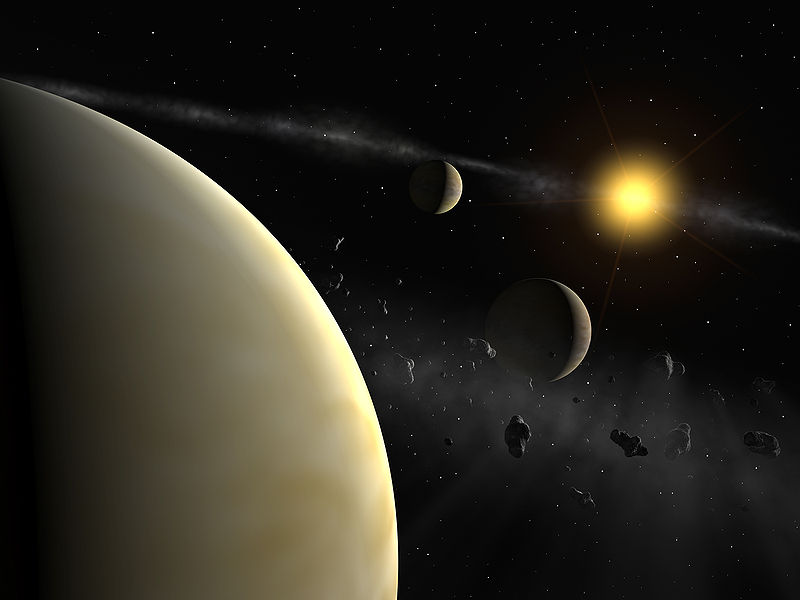Three New Planets Around Star Hd69830
Interview with
Chris - Well HD69830 might not be the most excitingly named star in our cosmic neighbourhood but it's certainly got researchers buzzing in Switzerland, because Christophe Lovis and his colleagues at the Geneva Observatory have found in orbit three rocky planets about the size of Neptune. They're too small to see directly; in fact it was the wobble they provoke in their home star that gave them away. But intriguingly, at least one of them is in the habitable zone, like the Earth, and that means that it might also be a home for liquid water.
 Christophe - We have discovered a multi-planet system with three very low mass planets and it's the first such system with such low mass planets and, of course, we are now beginning to discover planets that are only a few Earth masses in mass, so we are approaching planets of a really small size and its become very interesting.
Christophe - We have discovered a multi-planet system with three very low mass planets and it's the first such system with such low mass planets and, of course, we are now beginning to discover planets that are only a few Earth masses in mass, so we are approaching planets of a really small size and its become very interesting.
Chris - So, you're into the kind of size which is almost Earth-like and, therefore, very similar in terms of their capacity to support life perhaps?
Christophe - Yes, for example. So we are not sure now what is their exact composition, but of course if the mass is very low then these planets are very likely to be mostly rocky and in that case they would really look like the Earth.
Chris - So, where are these planets?
Christophe - They are around a nearby star. This is quite a bright star that can be seen with the naked eye and it's about 40 light years away from the earth and so these three planets are orbiting this star, which is quite like our sun, a little bit less massive, a little bit cooler, but still much like our sun.
Chris - And how did you actually make these observations?
Christophe - We used dedicated instrumentation which was developed with the goal of being able to discover possible extrasolar planets by measuring, very precisely, the radial velocity of the stars. All stars are moving across space and each star has its own velocity in space, and so when observed from the Earth we can measure the component of this velocity along our line of sight. So some stars are just receding from us and some stars are approaching. And on top of that, when they are orbited by planets, these planets will induce a little gravitational wobble on these stars and they will make oscillations around their centre of mass velocity and we are able to measure these very tiny radial velocity changes.
Chris - So you saw this star, literally, wiggling a bit in space?
Christophe - Yes.
Chris - But if it wiggles a bit, how do you know there's three planets then if you can't see them?
Christophe - The signal curve by a planet is expected to be like a sinusoid curve and when we observe this star we noticed that the radial velocity showed complicated changes that could not be only explained by one sine curve and after accumulating enough measurements and trying orbital solutions, we found that the best solution was when we fitted three planets on these radial velocity curves.
Chris - And where are these planets, in relation to the star itself?
Christophe - The first one orbits with a period of nine days, it is very, very close to the star. Much closer to the star than, for example, Mercury in our own Solar System. Then the second planet orbits in 30 days which is a little bit further away and, most interestingly, the third planet which orbits in about 200 days which becomes quite similar to the Earth and so it's about 60% of the Sun/Earth distance.
Chris - Is that within what we call the habitable zone, for this particular star then?
Christophe - Yes, for this particular star it would be at the inner edge of the habitable zone so that means just at the border where the temperature is low enough for water to become liquid and that's one of the definitions of the habitable zone.
Chris - Do you think there is water there? Or do you not know anything about the composition of these particular planets?
Christophe - At the moment we have to be very careful. From the observations we have now published, we cannot say anything about the composition of these planets but we have made some theoretical calculations that show these planets, actually the first two, are mainly made of rocks and the second one and the third on also contains a lot of ices, that means there is a lot of water, but this water is not necessarily in the liquid form, it could be in ice.
Chris - I guess we'll just have to watch this space for more fertile findings from HD69830 and its clutch of rocky worlds. That was Christophe Lovis from the Geneva Observatory describing the work he's published in this week's edition of Nature.
- Previous The Science of Well-being
- Next Science Update - testosterone










Comments
Add a comment